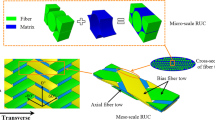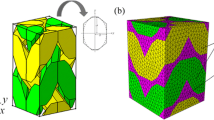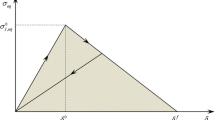Abstract
The multi-scale finite element model is presented to analyze tension and ballistic penetration damage characterizations of 2D triaxially braided composite (2DTBC). At the mesoscopic level, the damage of fiber tows is initiated with 3D Hashin criteria, and the damage initiation of pure matrix is predicted by the modified von Mises. The progressive degradation scheme and energy dissipation method are adopted to capture softening behaviors of tow and matrix. The macro-scale damage model is established by maximum-stress criteria and exponential damage evolution. To simulate interface debonding and inter-ply delamination, a triangle traction–separation law is adopted in each scale. Both scale damage models are verified with available experimental results. Based on numerical predictions, the stress–strain responses and damage developments of 2DTBC under axial and transverse tension loading are studied. For ballistic penetration loading, the meso-scale damage mechanisms of 2DTBC are predicted using 1/4 model, 1/2 model, 1-layer model, 2-layer model and 3-layer model. Then, effects of different model and impactor radius on damage modes are analyzed. Additionally, the macro-scale ballistic penetration behaviors of 2DTBC are simulated and compared with experiment. The prediction results for tension and penetration correlate well with experiment results. Both tension and penetration damage characterizations for tow, matrix within tow, pure matrix, interface and inter-ply delamination are revealed. A comparison of penetration damage between meso- and macro-scale presents a similar crack mechanism between two scales.








(Reproduced with permission from [18])



(Reproduced with permission from [18])



(Reproduced with permission from [27])










Similar content being viewed by others
References
Zhou L, Zeng J, Jiang L, Hu H (2018) Low-velocity impact properties of 3D auxetic textile composite. J Mater Sci 53(5):3899–3914
Yang CH, Ma WN, Ma DW (2018) Low-velocity impact analysis of carbon nanotube reinforced composite laminates. J Mater Sci 53(1):637–656
Ren Y, Zhang S, Jiang H, Xiang J (2018) Meso-scale progressive damage behavior characterization of triaxial braided composites under quasi-static tensile load. Appl Compos Mater 25(2):335–352
Zhang C, Xu X (2013) Finite element analysis of 3D braided composites based on three unit-cells models. Compos Struct 98(3):130–142
Kaboglu C, Mohagheghian I, Zhou J, Guan Z, Cantwell W, John S, Blackman BRK, Kinloch AJ, Dear JP (2017) High-velocity impact deformation and perforation of fibre metal laminates. J Mater Sci 53:4209–4228
Xu L, Huang Y, Zhao C, Ha SK (2016) Progressive failure prediction of woven fabric composites using a multi-scale approach. Int J Damage Mech 27:97–119
Key CT, Schumacher SC, Hansen AC (2007) Progressive failure modeling of woven fabric composite materials using multicontinuum theory. Compos Part B Eng 38(2):247–257
Pan Z, Gu B, Sun B, Xiong J (2017) Progressive failure of 3-D textile composites under impact loadings. Compos Struct 168:710–724
Zhang C, Curiel-Sosa JL, Duodu EA (2017) Finite element analysis of the damage mechanism of 3D braided composites under high-velocity impact. J Mater Sci 52(8):1–17
Xiao X, Kia HG, Gong XJ (2011) Strength prediction of a triaxially braided composite. Compos Part A Appl Sci Manuf 42(8):1000–1006
Goldberg RK, Blinzler BJ, Binienda WK (2010) Modification of a macromechanical finite-element based model for impact analysis of triaxially-braided composites. J Aerosp Eng 25(3):383–394
Goldberg RK, Blinzler BJ, Binienda WK (2010) Investigation of a macromechanical approach to analyzing triaxially-braided polymer composites. AIAA J 49(1):205–215
Blinzler BJ, Goldberg RK, Binienda WK (2012) Macroscale independently homogenized subcells for modeling braided composites. AIAA J 50(9):1873–1884
Zhang C, Li N, Wang W, Binienda WK, Fang H (2015) Progressive damage simulation of triaxially braided composite using a 3D meso-scale finite element model. Compos Struct 125:104–116
Binienda WK, Li X (2010) A mesomechanical model for numerical study of two dimensional triaxially braided composite. J Eng Mech 136(11):1366–1379
Zhang C, Binienda WK, Kohlman LW (2014) Analytical model and numerical analysis on the elastic behavior of triaxial braided composites. J Aerosp Eng 27(3):473–483
Song S, Waas AM, Shahwan KW, Xiao X, Faruque O (2007) Braided textile composites under compressive loads: modeling the response, strength and degradation. Compos Sci Technol 67(15):3059–3070
Li X, Binienda WK, Goldberg RK. Finite element model for failure study of two dimensional triaxially braided composite. NASA/TM-2010-216372
Wang C, Zhong Y, Adaikalaraj PFB, Ji X, Roy A, Silberschmidt VV (2016) Strength prediction for bi-axial braided composites by a multi-scale modelling approach. J Mater Sci 51(12):6002–6018
Zhang C, Binienda WK, Goldberg RK, Goldberg RK, Kohlman LW (2014) Meso-scale failure modeling of single layer triaxial braided composite using finite element method. Compos Part A Appl Sci Manuf 58(58):36–46
Zhang C, Binienda WK (2014) A meso-scale finite element model for simulating free-edge effect in carbon/epoxy textile composite. Mech Mater 76(9):1–19
Zhang C, Binienda WK (2014) Numerical analysis of free-edge effect on size-influenced mechanical properties of single-layer triaxially braided composites. Appl Compos Mater 21(6):841–859
Ha-Minh C, Imad A, Boussu F, Kanit T (2016) Experimental and numerical investigation of a 3D woven fabric subjected to a ballistic impact. Int J Impact Eng 88:91–101
Luan K, Sun B, Gu B (2013) Ballistic impact damages of 3-D angle-interlock woven composites based on high strain rate constitutive equation of fiber tows. Int J Impact Eng 57(1):145–158
Nilakantan G, Keefe M, Bogetti TA, Jr JWG (2010) Multiscale modeling of the impact of textile fabrics based on hybrid element analysis. Int J Impact Eng 37(10):1056–1071
Nie WZ, Binienda WK (2015) Effective mesomechanical modeling of triaxially braided composites for impact analysis with failure. Earth Space 503–512
Littell JD, Binienda WK, Arnold WA, Roberts GD, Goldberg RK (2009) Effect of microscopic damage events on static and ballistic impact strength of triaxial braid composites. Compos Part A Appl Sci Manuf 40(12):1846–1862
Li X, Binienda WK, Goldberg RK (2010) Finite element model for failure study of two dimensional triaxially braided composite. J Aero Eng 24(2):170–180
Littell JD (2008) The experimental and analytical characterization of the macromechanical response for triaxial braided composite materials. Ph.D. dissertation, University of Akron
Nobeen NS, Zhong Y, Francis BAP, Ji X, Chia ESM, Joshi SC, Chen Z (2016) Constituent materials micro-damage modeling in predicting progressive failure of braided fiber composites. Compos Struct 145:194–202
Zhang C, Mao C, Zhou Y (2017) Meso-scale damage simulation of 3D braided composites under quasi-static axial tension. Appl Compos Mater 24(5):1179–1199
Xia Z, Zhang Y, Ellyin F (2003) A unified periodical boundary conditions for representative volume elements of composites and applications. Int J Solids Struct 40(8):1907–1921
Zhang C, Curiel-Sosa JL, Bui TQ (2017) Comparison of periodic mesh and free mesh on the mechanical properties prediction of 3D braided composites. Compos Struct 159:667–676
Kassem GA, Weichert D (2009) Micromechanical material models for polymer composites through advanced numerical simulation techniques. Pamm 9(1):413–414
Jiang H, Ren Y, Gao B, Xiang J, Yuan FG (2017) Design of novel plug-type triggers for composite square tubes: enhancement of energy-absorption capacity and inducing failure mechanisms. Int J Mech Sci 131–132:113–136
Jiang H, Ren Y, Gao B (2017) Research on the progressive damage model and trigger geometry of composite waved beam to improve crashworthiness. Thin Wall Struct 119:531–543
Ren Y, Jiang H, Gao B, Xiang J (2017) A progressive intraply material deterioration and delamination based failure model for the crashworthiness of fabric composite corrugated beam: parameter sensitivity analysis. Compos Part B Eng 135:49–71
Hashin Z (1980) Failure criteria for unidirectional fiber composites. J Appl Mech 47(2):329–334
Lu Z, Xia B, Yang Z (2013) Investigation on the tensile properties of three-dimensional full five-directional braided composites. Comput Mater Sci 77(3):445–455
Lapczyk I, Hurtado JA (2007) Progressive damage modeling in fiber reinforced materials. Compos Part A 38(11):2333–2341
Fang GD, Liang J, Wang B (2009) Progressive damage and nonlinear analysis of 3D four-directional braided composites under unidirectional tension. Compos Struct 89(1):126–133
Matzenmiller A, Lubliner J, Taylor L (1995) A constitutive model for anisotropic damage in fiber-composites. Mech Mater 20:125–152
Sokolinsky VS (2010) Numerical simulation of the crushing process of a corrugated composite plate. Compos Part A 42(9):1119–1126
Maimí P, Camanho PP, Mayugo J-A, Dávila CG (2006) A thermodynamically consistent damage model for advanced composites. Technical Report NASA/TM-2006-214282, NASA
Zhang C, Xu X (2013) Finite element analysis of 3D braided composites based on three unit-cells models. Compos Struct 98(3):130–142
Alfano G, Sacco E (2010) Combining interface damage and friction in a cohesive-zone model. Int J Numer Methods Eng 68(5):542–582
Zhang C, Curiel-Sosa JL, Bui TQ (2017) A novel interface constitutive model for prediction of stiffness and strength in 3D braided composites. Compos Struct 163:32–43
Abaqus 6.10 Analysis user’s manual (2010) Dassault Systèmes
Benzeggagh ML, Kenane M (1996) Measurement of mixed-mode delamination fracture toughness of unidirectional glass/epoxy composites with mixed-mode bending apparatus. Compos Sci Technol 56(4):439–449
Zhang D, Chen L, Wang Y, Zhang L, Zhang Y, Yu K, Lu X, Sun J, Xiao X, Qian K (2017) Stress field distribution of warp-reinforced 2.5D woven composites using an idealized meso-scale voxel-based model. J Mater Sci 52:6814–6836
Acknowledgements
The authors acknowledge the financial supports from the National Natural Science Foundation of China (No. 11402011). The financial supports from Fundamental Research Funds for the Central Universities (No. 201401390741) are also gratefully acknowledged.
Author information
Authors and Affiliations
Contributions
YR helped with the research guidance, technological guidance, quality check of paper and writing level and final decision for submission. HJ contributed to the survey, programming of user material, finite element modeling (preprocessing and post-processing), picture and data processing, damage analysis of meso-scale and macro-scale triaxially braided composite under the tension loading and ballistic impact loading and writing of full text. SZ assisted with the part of work research, dealing of numerical computation error, programming study and numerical result discussion of meso-scale axial tension and transverse tension. ZL involved in numerical result discussion of meso-scale ballistic impact failure. LN contributed to the technological guidance.
Corresponding author
Ethics declarations
Conflict of interest
The authors declared no potential conflict of interest with respect to the research, authorship and/or publication of this article.
Rights and permissions
About this article
Cite this article
Jiang, H., Ren, Y., Zhang, S. et al. Multi-scale finite element analysis for tension and ballistic penetration damage characterizations of 2D triaxially braided composite. J Mater Sci 53, 10071–10094 (2018). https://doi.org/10.1007/s10853-018-2248-x
Received:
Accepted:
Published:
Issue Date:
DOI: https://doi.org/10.1007/s10853-018-2248-x




